Text and images by Vanessa Lovell , MA Fashion (Textiles for Fashion Pathway), Central Saint Martins
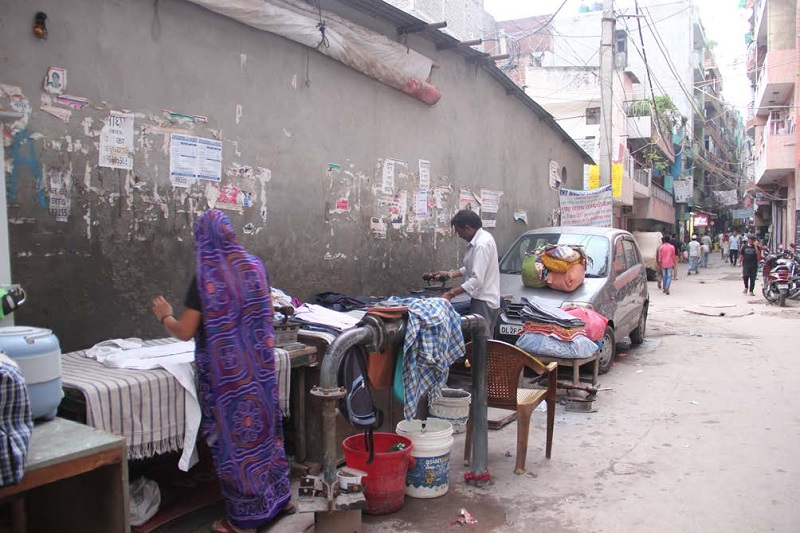
Ironing on the street, Khirki village
The Art for the Environment International Artist Residency Programme (AER) was launched in 2015 by member of the UAL Research Centre for Sustainable Fashion and UAL Chair of Art and the Environment Professor Lucy Orta and coordinated by CSF Associate Curator Camilla Palestra.
Vanessa Lovell is a current MA Fashion (Textiles for Fashion Pathway) student at Central Saint Martins, she was selected for the 2017 Art for the Environemnt International (AER) residency with KHOJ in New Delhi, India. Vanessa reports back to the Postgraduate Community at UAL here:
Based in the south of New Delhi, India, KHOJ International Artists Association initially began in 1997 as a proposed artistic space, catalyzing a movement that has drawn artists worldwide. Supporting local Indian artists and encouraging artists from further afield to engage with the local community, it continues to push the boundaries of Indian contemporary art practice.
I arrived at KHOJ on a Tuesday afternoon, after a considerable journey from London with a stop over in Abu Dhabi, an experience within itself. Even this brief touchdown brought to light a change of custom, tradition and language beyond what I had experienced before. On arrival at Delhi airport I was greeted by a taxi driver sent by KHOJ, to drive me to my temporary home for the month.
From the confines of the taxi I was able to experience the immense hustle along the streets in the midday lunchtime rush of Delhi. Food vendors and shops spilled out into the streets, cows stood in the middle of busy roads blocking traffic. I was not yet out on the streets, but I could already experience the immense sensory overload of the city. Turning off the main road, narrowly avoiding a speeding rickshaw, I was led down an un-made lane wide enough for one car and surrounded by three or four story tapering buildings. The place had the feel of a mini make shift city, busy and bustling with the buildings stacked like blocks, one spilling into another. KHOJ sits nestled in the middle of the urban village of Khirki, and is a white oasis of calm in an otherwise hectic pocket of Delhi.

Dyer, Khirki village
The project I proposed to undertake at KHOJ involved exploring the craftsmanship of textiles in India, more specifically those within the region I was based, identifying those artisans suffering in an era of mass production. I wanted to work with local craftsmen and workshops that utilise traditional techniques and explore their application to textiles, re-introducing these techniques to appeal to a wider market and to consequently increase demand in what is becoming a dwindling trade. I was particularly interested in the waste fabric of production, and finding a way to use the scraps of precious cloth produced by artisans, creating a fabric that in turn could be used in garments and apparel. I left my subject matter intentionally broad, as I was interested in exploring weaving, embroidery and printing and wanted to absorb as much information as possible about each technique to further apply these to my future work. Prior to my arrival, KHOJ informed me that many such workshops existed in the direct vicinity of the studio, and it would be best to make contact on arrival.

Embroiderers at the workshop across from KHOJ completing beaded Saris, Khirki village.After settling in, a tour of Khirki village was organised by KHOJ to help myself and another resident artist find our bearings. As we made our way down winding lanes it became clear Khirki was like no other place I had ever experienced. More of a maze than a village, it was not possible to navigate by map. The sprawling streets led to narrow lanes which in turn led to corridors that seem to run between houses like tunnels. At first it could be seen as intimidating, but after a while I grew accustomed to getting lost and it became part of the charm to discover new things on every venture outside. Equally as spellbinding are the production units within the village. The majority of buildings housed shops and informal food outlets, however peering down some open doors to basements I could see workshops and studios with fabric strewn floors. In one hut I found a dyer, his colourful fabrics hanging from a line sprawling into the street and next door a tracer, tracing designs onto paper for the embroidery work on Saris.
For the first ten days at KHOJ, my practice lead me on a trail around Delhi, visiting markets, museums, artists and workshops. I was determined to explore as much as possible and immerse myself into the field. After an initial meeting to discuss my project KHOJ were able to put me in touch with a previous artist of the institution, Priya Ravish Mehra, whose indigo dyed textiles and handmade paper are as traditional as they are contemporary, revitalising a craft and technique in a modern way. Priya was the first to flag the potential issues that I may face. Traditional Indian crafts were a dying trade, with businesses favoring cheaper and more efficient ways of production. Delhi is now predominantly a producer for the mass market, and most artisans and small tradespeople operate from villages and towns tied to their craft. The language barrier posed an issue, as most of the labourers did not speak any English. Time was also an issue, and my first week was spent finding my feet and getting used to the customs, culture and area of the Delhi.
In my second week, with the help of Zubin Ekka, a representative of KHOJ, I was able to revisit the workshops in Khirki with a translator. Across the street was an embroidery shop, where men
worked on both machine and hand embroidery. The owner, Shibi, explained to me the majority of his work was done by machine. Due to time and cost, only beading and small details were finished by hand. Traditional Indian hand embroidery was not feasible for him, as he fulfilled orders for clients worldwide. The next workshop we visited, deep in the heart of Khirki, we entered a room strewn with Kurtas ready to be packed into sacks, which provided further evidence of large scale production driven by online sales. After a brief chat with the owner, it was revealed the entire production of the garments was in Khirki, from the embroidery and stitching, to the block printing and packaging. He agreed to provide me with some waste fabrics to start working with, which I would be able to collect everyday of the week. Finding out the location of the block printers, we continued our way down the narrow winding lanes and after a short while came to a narrow opening to a basement where I could see a table pinned with black cotton pattern pieces. I would come back to this basement a few times during my stay taking photos, documenting, asking questions, and even block printing with the workers. The designs featured were basic decorative motifs of one or two colours in pigment and chemical print pastes. The workshop became an integral part of my project because of the proximity to KHOJ and the relationship I was able to build with the workers that enabled me to better grasp the technique and production methods. However, I realised that in order to understand and explore the most elaborate production of block prints, I would have to travel further afield.
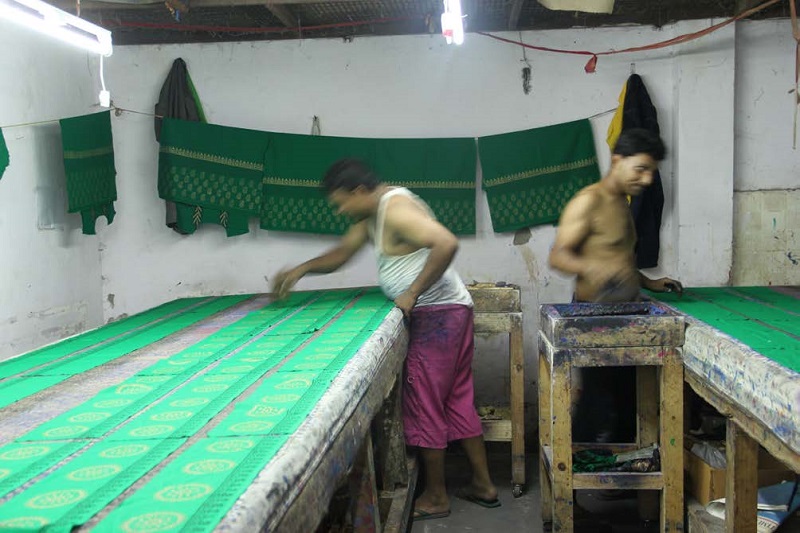
Blockprinters, Khirki village
Towards the end of my second week I boarded an early morning train to Jaipur, the home of block printing and vegetable dyeing. It was here that I was able to throughly experience block printing as a craft, going through each stage of production. On arrival I called Soma Block prints, one of two internationally renowned block printing companies based in Jaipur and arranged a meeting.
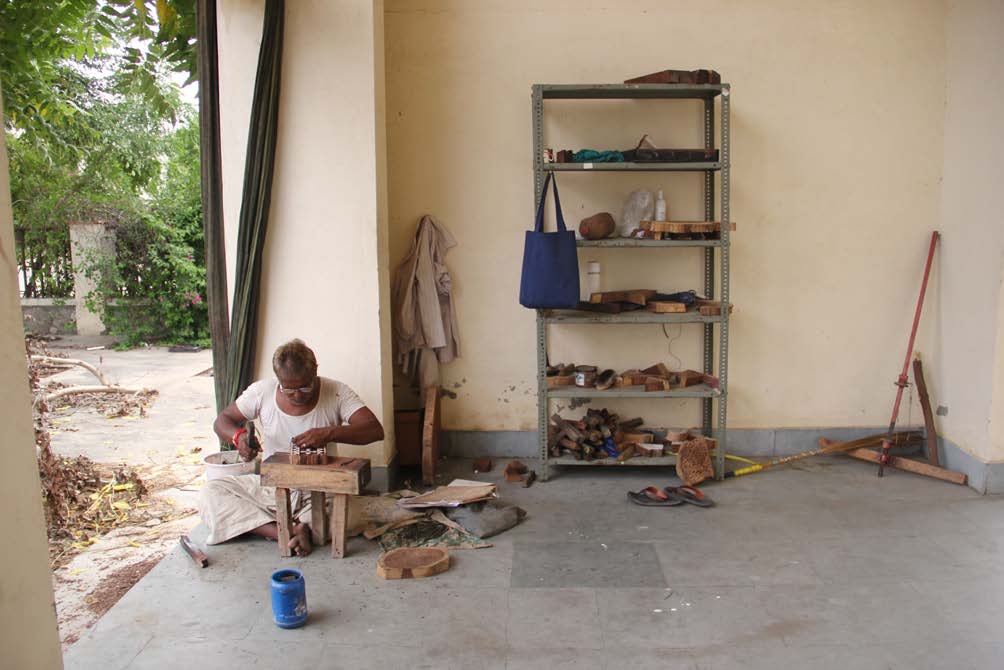
Block maker at Soma block prints, Jaipur
The companies factory is located in the southern town of Sanganer on an industrial estate surrounded by Indian countryside. Known for their colourful designs at Soma, each print can have up to seven layers with each motif intricately carved from cedar wood by their in house block maker. Although it was monsoon season and production had slowed, six tables were still in use, which allowed me to experience the process from start to finish.

Block printing at Agawali Txtiles, Jaipur.
The next day through a contact made on my visit I was able to organise my own block printing session in a small workshop just outside the pink city of Jaipur. In four hours I was able to print four meters of fabric with four layers. I was astounded by the speed at which fabric could be printed in this manner, compared with printing the equivalent with a screen, which would easily take up a whole day.
On my return to Delhi, I gathered my materials that I had collected and began to work on ways of showing my exploration and experience of techniques through exhibition. The workshop in Jaipur had similarly given me some waste fabric, which I was keen to work with. Collaborating with a local embroiderer, I commissioned a piece that reflected the different regional styles of Indian embroidery that had declined in recent years. Interestingly, he told me that although his workers knew the styles and stitches of most, rarely were they asked to embroider in a particular style from a specific region. I then set about creating tapestries from the waste pieces, hand-stitching patches together.

Open studios presentation, KHOJ
The slow method of stitching became cathartic for me, a way of feeling the cloth and engaging with the provenance of each piece. The end result was a set of three tapestries, each reflecting a different aspect of Indian craft, showing a different step in my journey and could be traced back to a workshop that I had connected with. KHOJ organised an open studio event to showcase my final pieces and assisted me with the presentation, organisation, and PR. My final exhibition consisted of my three tapestry pieces, suspended on wooden frames, an installation featuring the backing cloth of the Khirki block-printers I had frequented, wooden blocks commissioned from a local block maker of my own design, and a series of photographs documenting the handiwork of the labourers was featured.
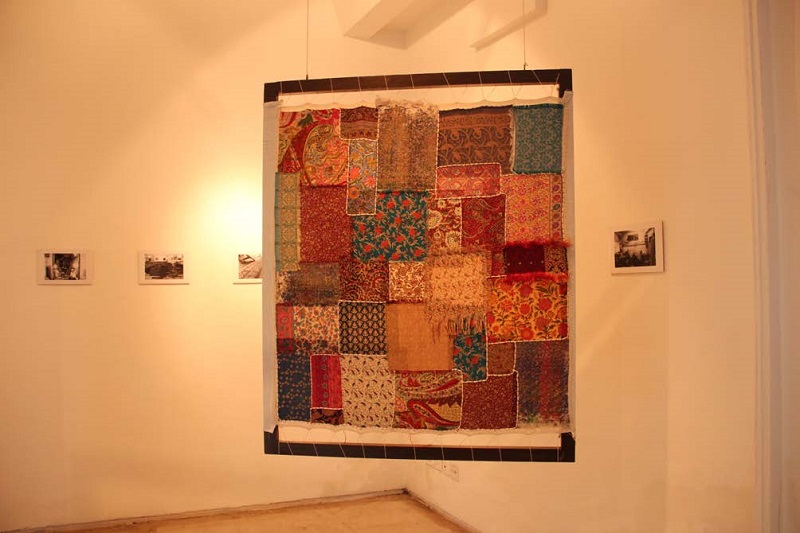
Open studios presentation, KHOJ
My time in India was one of incredible learning and discovery, not only within the field of textiles, but socially and culturally. The residency for me was as much concerned with the experience as it was about the work that I produced along the way and it has opened up a range of opportunities and possibilities through contacts made and techniques acquired. The blocks made for me will
definitely play a part in my final collection to come. The rise of large scale production in Delhi made it difficult to find the traditional artisans and craftsmen that I was searching for, however the
strength and international demand of the smaller companies I did interact with, such as Soma, is proof of contemporary interest in slow trade artisanal processes and the quality they provide.
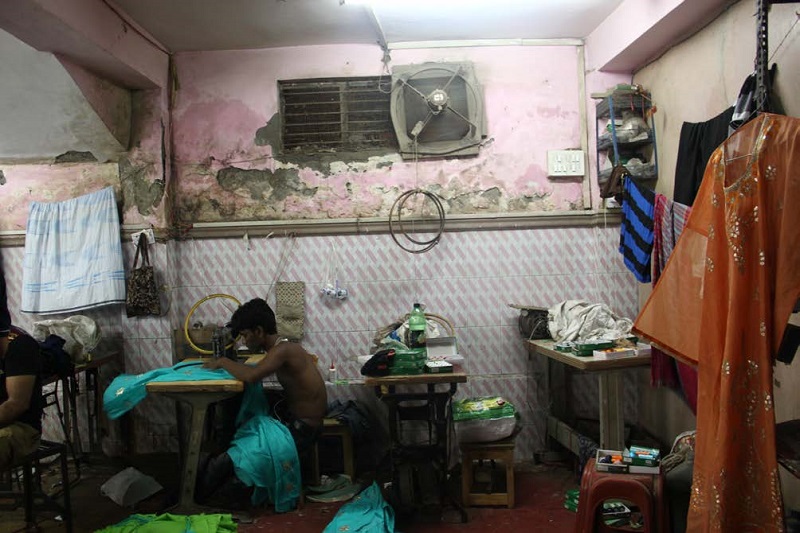
Machine embroiderer, Khirki village
I would like to thank KHOJ for hosting me as resident artist, and for supporting me during my stay. I would especially like to thank Zubin Ekka, who took time to accompany me on my visits and acted as translator, and Mila Samdub, who helped with the organisation during my stay. Thank you to all who contributed to my exploration, allowing me to view their work, and taking time to show me their methods. Lastly thank you to Camilla Palestra and Lucy Orta from UAL’s Centre for Sustainable Fashion, for making my residency possible and for this amazing opportunity to revive Indian crafts.
Related Links:
- The Art for the Environment International Residency Programme
- UAL Research Centre for Sustainable Fashion
- Lucy Orta UAL Research Profile
- Vanessa Lovell Website
- KHOJ Website
- AER KHOJ 2017 Residency Details
The Art for the Environment International Residency Programme (AER):
In 2015, internationally acclaimed artist, Professor Lucy Orta UAL Chair of Art for the Environment – Centre for Sustainable Fashion, launched the Art for the Environment Residency Programme (AER), in partnership with residency programmes across Europe. Applicants can choose from a 2 to 4 week period at one of the hosting institutions, to explore concerns that define the twenty-first century – biodiversity, environmental sustainability, social economy, human rights – and through their artistic practice, envision a world of tomorrow.
Through personal research, studio production time, critiques and mentoring sessions with Lucy Orta and a selection of Europe’s most exciting cultural institutions, the residency programme provides a platform for creative individuals, working across various disciplines, to imagine and create work that can make an impact on how we interact with the environment and each other.
A distinguished selection panel assess the applicants for this unique opportunity to partake in the UAL Art for the Environment Residency Programme.
NOTE: Applications accepted from UAL graduates, postgraduates and recent alumni (within 12 months from graduation date).

